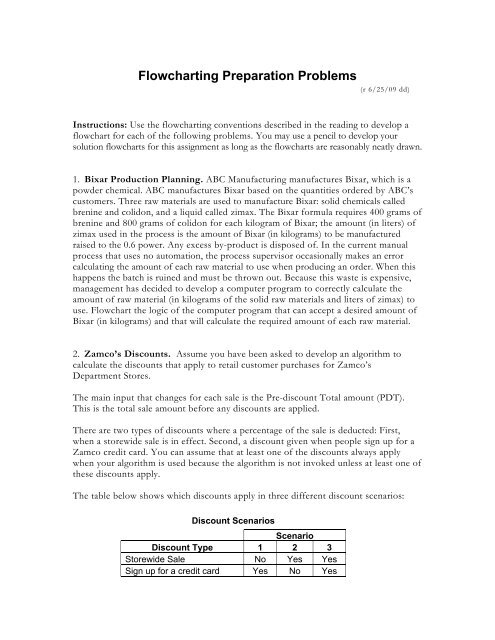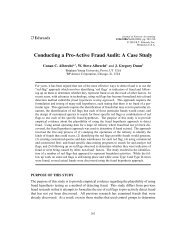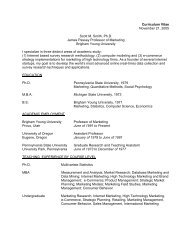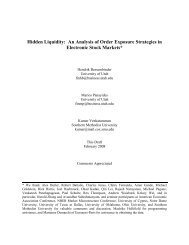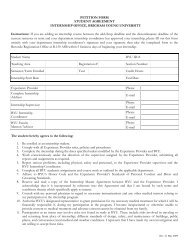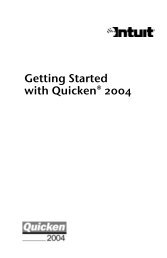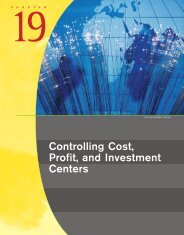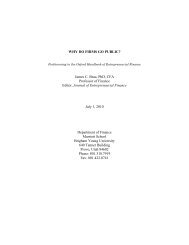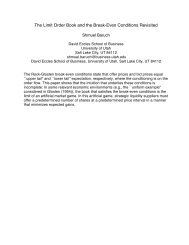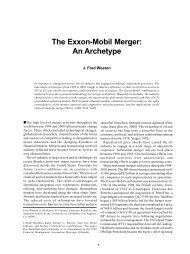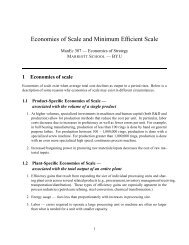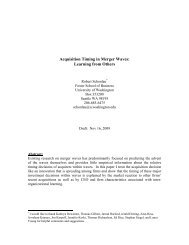Flowcharting Preparation Problems - Marriott School
Flowcharting Preparation Problems - Marriott School
Flowcharting Preparation Problems - Marriott School
- No tags were found...
Create successful ePaper yourself
Turn your PDF publications into a flip-book with our unique Google optimized e-Paper software.
<strong>Flowcharting</strong> <strong>Preparation</strong> <strong>Problems</strong>(r 6/25/09 dd)Instructions: Use the flowcharting conventions described in the reading to develop aflowchart for each of the following problems. You may use a pencil to develop yoursolution flowcharts for this assignment as long as the flowcharts are reasonably neatly drawn.1. Bixar Production Planning. ABC Manufacturing manufactures Bixar, which is apowder chemical. ABC manufactures Bixar based on the quantities ordered by ABC’scustomers. Three raw materials are used to manufacture Bixar: solid chemicals calledbrenine and colidon, and a liquid called zimax. The Bixar formula requires 400 grams ofbrenine and 800 grams of colidon for each kilogram of Bixar; the amount (in liters) ofzimax used in the process is the amount of Bixar (in kilograms) to be manufacturedraised to the 0.6 power. Any excess by-product is disposed of. In the current manualprocess that uses no automation, the process supervisor occasionally makes an errorcalculating the amount of each raw material to use when producing an order. When thishappens the batch is ruined and must be thrown out. Because this waste is expensive,management has decided to develop a computer program to correctly calculate theamount of raw material (in kilograms of the solid raw materials and liters of zimax) touse. Flowchart the logic of the computer program that can accept a desired amount ofBixar (in kilograms) and that will calculate the required amount of each raw material.2. Zamco’s Discounts. Assume you have been asked to develop an algorithm tocalculate the discounts that apply to retail customer purchases for Zamco’sDepartment Stores.The main input that changes for each sale is the Pre-discount Total amount (PDT).This is the total sale amount before any discounts are applied.There are two types of discounts where a percentage of the sale is deducted: First,when a storewide sale is in effect. Second, a discount given when people sign up for aZamco credit card. You can assume that at least one of the discounts always applywhen your algorithm is used because the algorithm is not invoked unless at least one ofthese discounts apply.The table below shows which discounts apply in three different discount scenarios:Discount ScenariosScenarioDiscount Type 1 2 3Storewide Sale No Yes YesSign up for a credit card Yes No Yes
3. Jim’s Years to Accumulate. Jim often counsels customers at his bank. He needs acomputer program that will calculate the number of years (Y) it will take to accumulatea specified future amount (A) of money based on a given initial deposit (D) andspecified interest rate (R). Assume interest compounds annually.Here is the variable legend:Variable LegendS = Specified AmountD = Initial DepositR = Interest Rate (%)A = Actual Future AmountY = Number of YearsThe finance formula to calculate an actual future amount (A) given D, R, and Y is asfollows:A = D * (1 + R/100)^YDraw a flowchart for an algorithm to produce the answers. Your flowchart shouldaccept S, D, and R. The algorithm should display S, D, R, A, and Y. The number ofyears (Y) is the number of years required for the actual amount (A) to equal or exceedthe specified future amount (S).Use looping (i.e., “repetition” or “iteration”) in your program. Using the exampleinputs shown below, create a loop termination table with appropriate values todemonstrate that your algorithm uses a correct loop termination condition. Includethis table with your flowchart in your answer.Example Inputs for Loop Termination TableS = 1300D = 1000R = 10


